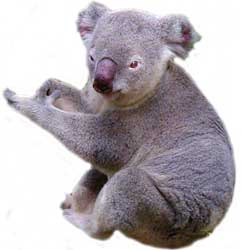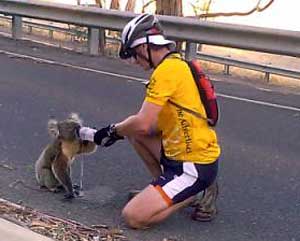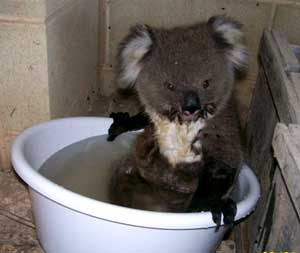 Accommodation | International
Flights | Domestic
Flights | Tours
| Travel
Insurance | Car
Hire | Visas
| Shopping
| Dating
| Humour
Accommodation | International
Flights | Domestic
Flights | Tours
| Travel
Insurance | Car
Hire | Visas
| Shopping
| Dating
| HumourKoala

The Koala (Phascolarctos cinereus) is a solidly built arboreal marsupial herbivore native to Australia, contrary to popular misconception it is NOT a koala bear, and in no way even related to any bears, even many Aussies don't even know this and refer to this animal as a koala bear !
The koala lives in the coastal regions of eastern and southern Australia, from Adelaide to the southern part of Cape York Peninsula, and also on coastal islands like Kangaroo Island and Magnetic Island, but not in Tasmania and Western Australia
They also live further inland in regions with enough moisture to support suitable eucalypt woodlands.
The koalas of South Australia nearly disappeared during the early
part of the 20th century due to hunting for their fur, then known
as known as Adelaide Chinchilla, but the state has since been repopulated
with Victorian koalas.
The name koala comes from the Aboriginal name Dharuk gula. The scientific
name Phascolarctos for koala originates from the Greek phaskolos
"pouch" and arktos "bear". Its species name,
cinereus, is Latin and means "ash-coloured".
Koalas can vary from state to state, the Victorian koala has longer, thicker fur, is a darker, softer grey, often with chocolate-brown highlights on the back and forearms, and has a more prominently light-coloured ventral side and fluffy white ear tufts. A typical New South Wales koala weighs about 12 kg for males and 8.5 kg for females. In Queensland the koala is smaller at around 6.5 kg for an average male and just over 5 kg for an average female and a lighter often rather scruffy grey in colour, and has shorter, thinner fur.
 Climbing Koalas T-Shirt - Double Sided |
 Koala Habitat T-Shirt |
 Koala Habitat Velvet Effect T-Shirt - Glow in the Dark |
The origins of the koala are not clear, but most likely they originated
from wombat-like animals.
Koala fossils are very rare, but some have been found in northern
Australia dating back 20 million years. During this time the northern
half of Australia was covered in dense rainforests. The koala specialised
in a diet of eucalypts when the climate cooled and eucalyptus forests
grew in the place of rainforests. The fossil records show that up
to 50,000 years ago, the southern regions of Australia were inhabited
by giant koalas.
Koalas that are disturbed can be violent, their teeth and claws
quite capable of injuring humans.
In May 2005 Tommy Stephenson was attacked by a koala in Melbourne.
The koala had descended from its tree and badly scratched Tommy's
leg, who received some bandages and a tetanus shot but was otherwise
OK. The koala has large, sharp claws to assist with climbing tree
trunks and their five fingers are arranged with opposable thumbs,
providing a better grip on the tree. The first two fingers are positioned
in apposition on the front paws and the first three fingers for
the hind paws. The koala is one of the few mammals (other than primates)
that has fingerprints. Koala fingerprints are so similar to human
fingerprints that even with a microscope it can be difficult to
tell the two apart.
The koala has an unusually small brain, with about 40% of the cranial
cavity being filled with fluid, while the brain itself is like "a
pair of shrivelled up walnut halves", in contact neither with
each other nor the bones of the skull. It is the only animal on
Earth (besides Paris Hilton) with such a strangely reduced brain.


Koala Line up
Buy
this Art Print at AllPosters.com
Koalas are generally silent, but males are capable of a very loud
mating call that can be heard from almost a kilometre away during
the breeding season. When under stress, koalas may produce a loud
cry, which sounds similar to a human baby. In captivity they have
been observed to live up to 18 years, but not much is known about
life expectancy in the wild.
Females reach maturity at 2 to 3 years of age, males at 3 to 4 years.
The mating season runs from October to March and a healthy female
koala can give birth to one young each year for about 12 years,
the gestation period is 35 days.
A baby koala is called a joey and is hairless, blind, and earless.
At birth the joey, only about seven millimetre long, crawls into
the downward-facing pouch on the mother's belly (which is closed
by a drawstring-like muscle that the mother can tighten at will)
and attaches itself to one of the two teats. Young remain hidden
in the pouch for half a year, feeding on milk only. During this
time they grow ears, eyes, and fur. The joey then begins to explore
outside of the pouch. At this stage it begins to consume small quantities
of the mother’s "pap" (formerly thought to be excrement,
but now thought to come from the mother's caecum) in order to inoculate
its gut with the microbes necessary to digest eucalypt leaves.
The baby koala will remain with the mother for another half a year,
riding on her back and feeding on both milk and eucalypt leaves
until they are about one year old. Young females disperse to nearby
areas at that time young males often stay in the mother's home range
until they are two or three years old.
Koalas spend about three of their five active hours eating. Feeding
occurs at any time of day, but usually at night. Koalas will eat
the leaves of about 120 out of about 700 different eucalypt types,
on average about half to one kilo of eucalypt leaves each day. That
was the main reason for a zoo in California to get rid of their
koalas, shipping the special Eucalyptus leaves in left the zoo with
a $100,000.- a year food bill! To digest this diet of not very nutritious
gum leaves they have, for their size, the longest appendix in the
world. They usually obtain all their water from the leaves but can
drink when they feel the need to. The liver deactivates the toxic
components ready for excretion, and the hind gut (especially the
caecum) is greatly enlarged to extract the maximum amount of nutrient
from the poor diet. Much of this is done through bacterial fermentation:
when young are being weaned, the mother passes unusually soft faeces,
called pap, which is rich in these bacteria, thus passing these
essential digestive aids on to her offspring.

Like wombats and sloths, koalas have a very low metabolic rate
for a mammal and they rest motionless for about 18 to 20 hours a
day, sleeping most of that time.
It is a wide spread Aussie myth that koalas are always stoned out
of their brains from eating eucalyptus leaves and therefore never
move, eucalyptus leaves have no intoxicating compounds like marijuana.
In recent years some colonies have been hard hit by disease, especially the sexually transmitted disease chlamydia. Koalas need large areas of forest and will travel long distances along tree corridors in search of new territories and mates. The ever-expanding human population of the coastal parts of the continent continues to cut these corridors by agricultural and residential development, forestry and road-building, isolating koala colonies.
In contrast to the dire situation on much of the mainland where
populations are declining, the koalas of many island and isolated
populations have reached "plague" proportions.
On Kangaroo Island in South Australia, koalas introduced in the
1920's have thrived in the absence of predators and competition
but this has caused the koala populations to become unsustainable
and threaten the Island's unique ecology. Especially the Manna Gum
trees are being stripped by koalas at a rate faster than they can
regenerate, endangering local birds and other animals that rely
on them.
Although only about 18 koalas were introduced in the 1920's their
numbers on Kangaroo Island are currently estimated at more than
25,000, while it is estimated that 10,000 at most is sustainable.
Culling has been consider by the South Australian Government as
a way of reducing koala numbers, but this met with fierce opposition
both domestically and internationally, and the koala remains protected.
So far sterilisation and translocation programmes have had only
limited success in reducing numbers and are an expensive method.
Koalas relocated to the mainland have had difficulty establishing
themselves in their new environment. Hormonal implants that can
be injected via darts are also considered.
Every year thousands of koalas are caught by a team of catchers
and put on a chartered plane to Mount Gambier in South Australia..
You can not legally keep a koala as a pet in Australia without
a permit.
Koalas normally get all the water they need from the leaves they eat and do not drink, but during Victoria's Black Saturday bushfires in 2009 the heat and drought got that bad that koalas were found drinking from swimming pools and coming to people's houses for a drink and a cooling bath !
 |
 |
Feel free to add something to our koala page !
HOME PAGE
Tourist Information
General Information
And Entertainment
ACCOMMODATION IN AUSTRALIA
Bed
& Breakfast
Budget
Accommodation
Backpackers Hostels
Hotels
in Australia
CAR HIRE IN AUSTRALIA
Australia Rental Cars
And
Campervans

TOURS
IN AUSTRALIA
What To Do In Australia
On-line
Shopping
On-line
Dating
![]()
About
Australia
Visas For Australia
How
To Get To Australia
How To Get Around
Travel Insurance
Travel Guides
Working
In Australia
Australian
Posters
Survival
Tips
Weather,
When To Go

Use of
this website constitutes acceptance of the User Agreement for this website
Contact us |
Advertise on this site
| Link to this site |Add
your photos or stories to this site |
Webmasters | Affiliates

